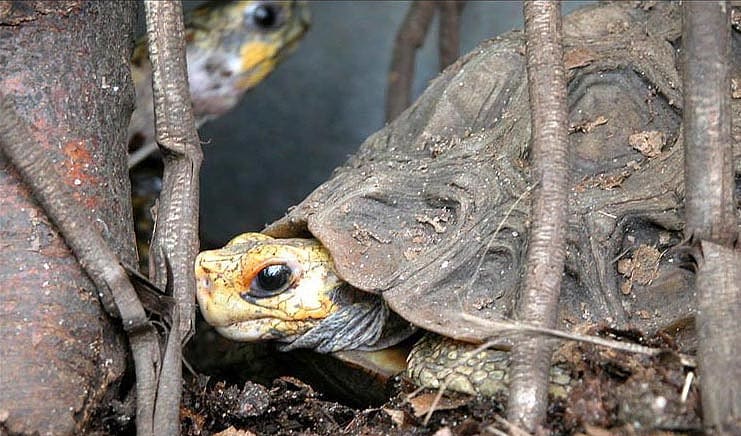Care information for the Homne's Hingeback tortoise.
Home’s Hingeback Tortoise
(Kinixys homeana)
- Size: 6 to 9 inches.
- Life Span: 25 to 60 years.
- Range: West Africa, from Liberia, east to Cameroon, and in the Democratic Republic of the Congo.
- Natural Habitat: Tropical swamps; tropical and subtropical lowland forests.
Captive Housing:
Shy and light-sensitive, cover is important for this species. A standard tortoise tank measuring about 4 feet long, 2 feet wide and 18 inches tall can house up to three or four adults, or a bunch of babies. Use ground or shredded coconut core as a substrate. Place a shallow water bowl at one end that’s large enough for a tortoise to sit in. Place various hides about the tank, making sure there’s enough to accommodate each tortoise. Place a layer of sphagnum moss on top of the coconut bedding and under the hides. Moisten the substrate with water to create a humid tank but not sopping wet. Spray or pour water into the tank substrate as needed to keep a humidity of about 77 to 85 percent. An automatic mister can work well for this purpose.
These tortoises are not big fans of intense lighting, so use a ceramic heat emitter to create a basking spot of about 85 degrees Fahrenheit. Place the emitter near the center of the enclosure, as opposed to one end. This gives a fairly even thermo gradient from the center to the ends of the tank. Ultraviolet lighting is not as important with this species as with other tortoises, but I would suggest providing UV lighting in the form of a T8 bulb over the tank, trying to produce as little visible light as possible. Leave the heat emitter on 24 hours a day, and set the UV lamp for a 12 hour on/off cycle.
Diet: Home’s are omnivores. They do well on dark, leafy greens, such as mustard and collard greens and kale. They also enjoy fruit or melon once per week. Offer fresh greens three times a week. In the wild, they have been found eating slugs, small rodents and carrion. In captivity, they will accept pre-killed mice, canned dog and cat food, and ours do well on canned Tortoise & Lizard Diet by Zoo Med. They are also fond of softened monkey biscuits. We offer the meat-based diets about twice a week. We supplement food items with a calcium/multivitamin supplement at each feeding.
What’s Available: Most hingeback tortoises for sale in the United States are imported from Africa. They usually land in pretty bad shape due to the collecting and shipping process. Being shy to begin with, it is often hard to tell the difference between a tortoise on its death bed and one that is just really shy, but weight is a telling sign. The tortoise should feel hefty in your hand. Avoid animals with discharge coming from the eyes, mouth or nose. Take your tortoise to a qualified reptile veterinarian for a checkup and worming. Babies are sometimes found for sale, but they are far and few. Captive breeding is increasing, but at a tortoise pace. If you can find a captive-bred one for sale, buy it. You can find hingebacks at reptile shows, select pet and reptile stores, and sometimes online. REPTILES
Ken Foose produced his first captive-bred snakes at age 11. With a Master’s Degree in Zoology, he has been both zookeeper and curator. He opened Exotic Pets, which specializes in reptiles and amphibians, in Las Vegas in 1991, and he is currently president of the International Herpetological Symposium.


